Indiana's Housing Market in 2013
It took a while, but Indiana’s housing market now appears to be squarely on the road to recovery. Over a 12-month period ending in June 2013, for instance, the number of houses sold in Indiana increased by nearly 17 percent over the previous year and house prices climbed more than 3 percent (see Table 1). With building permits up roughly 12 percent over the same period, the boost in demand is beginning to spill over to the new construction market too. The state’s foreclosure rate is still too high, but it has fallen precipitously since the end of 2011.
Table 1: Indiana Housing Market by the Numbers
| Indicator | U.S. | Indiana |
|---|---|---|
| Existing Home Sales between July 2012 and June 2013, Year-over-Year Change | 10.4% | 16.5% |
| House Price Appreciation, 2012:2 to 2013:2 | 7.5% | 3.2% |
| Residential Building Permits between July 2012 and June 2013, Year-over-Year Change | 28.6% | 11.6% |
| Share of Mortgages Seriously Delinquent, 2013:1 | 5.9% | 6.2% |
| Share of Mortgages with Negative Equity, 2013:1 | 19.8% | 11.6% |
Sources: Indiana Association of Realtors, National Association of Realtors, Federal Housing Finance Agency, U.S. Census Bureau, Mortgage Bankers Association, CoreLogic
Of course, given the depth of the housing slump, there are still a few more miles left on the path to a healthy market. Existing home sales in Indiana are still more than 10 percent off the 2007 mark, and the share of mortgages that are seriously delinquent is only about two-thirds of the way back to the state’s pre-crash level. Meanwhile, despite the recent uptick, residential construction activity in the first half of 2013 is still at low levels last seen in the early 1980s.
This article examines some of the latest data in order to gauge the state of Indiana’s housing market.
Home Sales Off to a Strong Start in 2013
After five years of flagging home sales numbers, Indiana finally had a breakout year in 2012. The state’s sales tally last year was up nearly 15 percent over 2011 and was its strongest annual figure since 2007. Sales totals are still well below the peak years of the mid-2000s, but it seems unlikely (and undesirable) that Indiana will reach those heights again anytime soon. After all, it was the overheated housing market during this period that helped fuel the state’s foreclosure crisis that began in 2006.
As Figure 1 shows, the rebound in existing home sales continued to improve early in 2013. The 14,700 existing home sales in Indiana during the first quarter of this year was an 18 percent improvement over the same period a year ago and was the state’s highest first quarter mark in the last six years. Meanwhile, sales in the second quarter were also up 18 percent year-over-year and represent Indiana’s best quarterly sales performance since mid-2007.
Figure 1: Indiana Home Sales by Quarter, 2008:1 to 2013:2
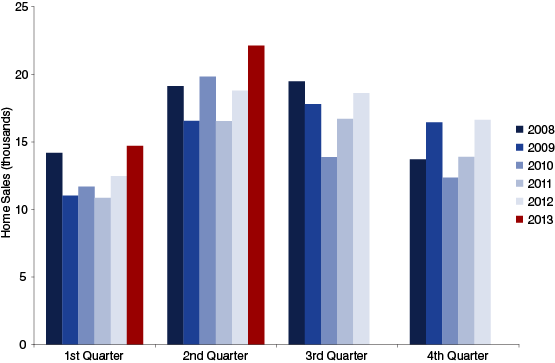
Source: Indiana Association of Realtors
Note: Sales figures are grouped by quarter because home sales are highly seasonal
As several recent media reports have highlighted, large investor groups are playing a role in the rebound in existing home sales and prices. As homeownership rates and house prices declined in recent years, more and more real estate investment trusts (REIT) have been purchasing single-family homes and converting them into rental properties. This trend first emerged in some of the country’s housing crash hot spots but now appears to be more widespread. As of July 2013, for instance, the REIT American Homes 4 Rent (AHR) reportedly holds a portfolio of more than 1,700 homes in the Indianapolis area—most of which were purchased in the last year.1 A check of AHR’s website shows that they also have properties in Bloomington, Columbus, Lafayette and Northwest Indiana.
While investor groups are helping to boost the numbers in some markets, Figure 2 shows that the uptick in existing home sales is widespread around the state. Over the 12-month period ending in June 2013, each of Indiana’s metro areas had an increase in home sales, led by the Indiana portion of the Louisville metro area with a 26 percent jump compared to the same period a year earlier. With a 23 percent increase, Gary had the second-largest increase in sales followed by the Indianapolis-Carmel-Anderson area (22 percent), Michigan City-LaPorte (20 percent) and Bloomington (16 percent).
Figure 2: Total Home Sales by Metro Area, Year-over-Year Change, July 2012 to June 2013
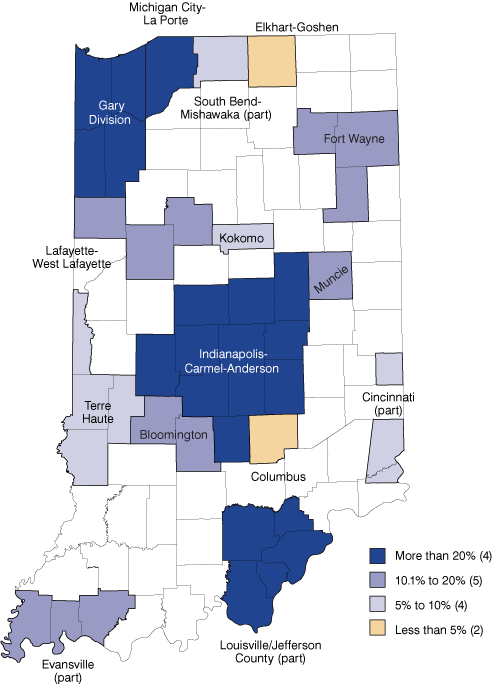
Source: Indiana Association of Realtors
Columbus and Elkhart-Goshen registered the lowest growth rates over this period but that does not necessarily indicate that these markets are underperforming. In the case of Columbus, at least, its housing market was already relatively strong heading into this period so it didn’t have much ground to make up.
The 48 counties that are outside of metro areas combined to post a 10 percent increase in sales. Among counties with at least 100 sales, Tipton County had the largest increase at 46 percent followed by Ripley (36 percent), Jackson (31 percent) and Dubois (27 percent) counties. Statewide, sales were up roughly 17 percent over this period.
Indiana House Prices on the Rise
As demand for existing homes in Indiana has increased, so have prices. According to the Federal Housing Finance Agency’s House Price Index (HPI), Indiana has seen price appreciation for eight consecutive quarters dating back to mid-2011 and the state’s home prices in the second quarter of 2013 are up 3.2 percent year-over-year (see Figure 3). This rate of appreciation ranked 37th-fastest among states and outpaced neighboring Kentucky (1.6 percent), but trailed Illinois (3.6 percent), Ohio (3.6 percent) and Michigan (12.1 percent). Nationally, prices are up 7.5 percent over this period.
Figure 3: House Price Index, Indiana and the United States, 1991:1 to 2013:2
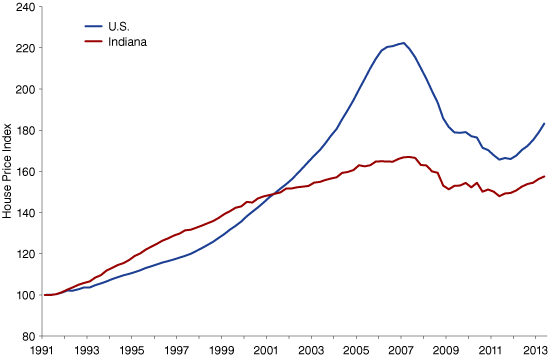
Source: Federal Housing Finance Agency, House Price Index (expanded data series, seasonally adjusted)
Fortunately, price appreciation has been widespread around the country over the past year (see Figure 4). Several of the hardest-hit states during the crash posted the greatest gains led by Nevada (23.8 percent increase), California (19.6 percent) and Arizona (19.5 percent). Of course, the gains in these states come on the heels of dramatic declines in recent years. With a 0.6 percent decline, only Vermont saw house prices slide in the last year.
Figure 4: Change in House Price Index by State, 2012:2 to 2013:2
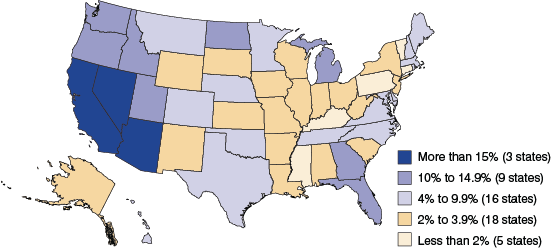
Source: Federal Housing Finance Agency, House Price Index (expanded data series, seasonally adjusted)
It’s important to put the changes in Indiana’s house prices in perspective. Unlike many other areas of the country that experienced great booms and busts in housing prices, Indiana had no price bubble at all. Instead, changes in Hoosier house prices have been glued to the state’s economic performance.
A look at the ratio of median sales prices to median household income best illustrates this point. Among the states that headlined the housing bubble, the price-to-income ratios in Florida and Nevada more or less doubled between 2000 and 2005 while prices in California soared to nine times its median household income (see Figure 5). Looking at some of Indiana’s neighbors, Illinois also saw a significant jump in this measure and even struggling Michigan’s ratio climbed modestly.
Since the onset of the housing slump, however, the price-to-income ratio in each of these states tumbled back to the more sustainable levels seen during the 1990s. All the while, through a relative boom period in the 1990s and two recessions during the 2000s, Indiana’s ratio has held remarkably steady over the last two decades.
Figure 5: Ratio of Median Sales Price to Median Household Income, Indiana and Select States, 1991 to 2011
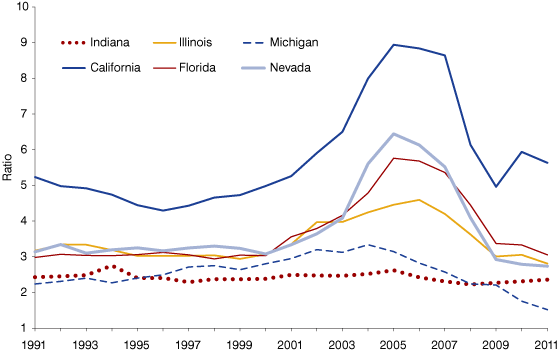
Source: U.S. Census Bureau and Moody’s Economy.com
Foreclosure Wave Begins to Recede
One of the key factors behind climbing house prices has been the declining foreclosure rate. The mortgage technology firm FNC Inc. reports that, at the depth of the crisis in early 2009, a little more than one-third of all U.S. home sales were foreclosed properties. At the same time, these foreclosures were selling at 25 percent below market value.
As the foreclosure situation improved, however, its effect on prices has diminished. At the national level, foreclosures as a share of sales had been cut in half to 18 percent by the fourth quarter of 2012. FNC indicates that the foreclosure discount has fallen to 12 percent during the same period, which is comparable to foreclosure discount estimates before the housing bust.2
This situation should continue to improve as the volume of lender-owned properties decline in Indiana and around the country. Figure 6 shows that the state has seen a precipitous decline in its foreclosure rate since the end of 2011. According to the Mortgage Bankers Association, the state’s foreclosure rate has declined more than 1 percentage point from 4.94 in the fourth quarter of 2011 to 3.49 in mid-2013. Even with this sharp decline, Indiana’s foreclosure rate remains above the U.S. average and ranks 14th-highest among states.
Figure 6: Share of Mortgages in Foreclosure, 1979:1 to 2013:2
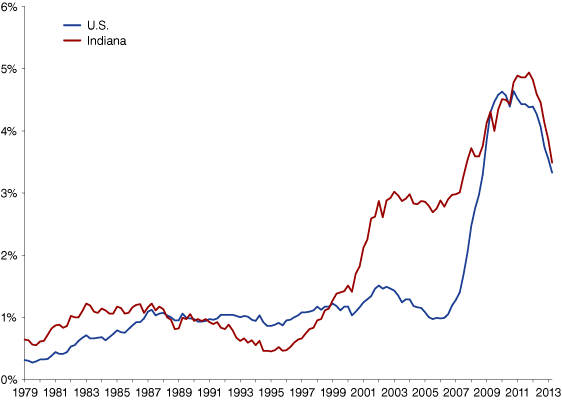
Source: National Delinquency Survey, Mortgage Bankers Association
Residential Construction Improving, but Still Weak
As with other areas of the housing market, residential investment is beginning to show signs of life but remains very low by historic standards. In 2012, the number of permits issued for new housing units in Indiana was less than one-third of the peak level seen in 1999 and was the fifth-lowest mark since 1960. However, the number of units last year was up 9 percent over 2011. The rebound has been even stronger so far this year, as the number of units through the first half of 2013 is 21 percent greater than for the same period in 2012.
One way to demonstrate how steep the decline in home building has been is to compare the changes in annual housing permits to existing home sales. From 1988 to 2005, there were approximately two existing home sales for each single-family housing permit in Indiana, but in 2012 the ratio was greater than six-to-one (see Figure 7). As the foreclosure rate declines and the market continues to improve, this gap should begin to close over the next few years.
Figure 7: Indiana Existing Home Sales and Single-Family Housing Permits, 1988 to 2012

Source: U.S. Census Bureau, Moody’s Economy.com
Looking Ahead
This resurgence in the housing market has occurred even though the drivers of housing demand—a strong labor market, migration and access to credit—are still not firing on all cylinders. Indiana did add nearly 55,000 jobs between July 2012 and July 2013, but the state’s unemployment rate remained stuck at 8.4 percent over that period. Data on migration trends are not as current, but Indiana had a net outflow of residents each year between 2010 and 2012. Meanwhile, historically low mortgage interest rates have led to unprecedented housing affordability conditions (see Figure 8), but tighter lending standards may have kept some creditworthy borrowers from accessing them.3
Figure 8: Mortgage Interest Rates and Indiana Housing Affordability Index, January 1979 to August 2013
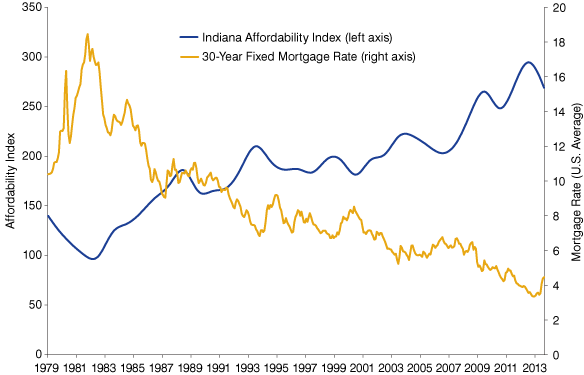
Note: An index value of 100 means that a state’s median household income is exactly enough to qualify for a mortgage on a median-priced home. Values above 100 indicate that the median income is more than enough to qualify. Indiana’s index value was 269 in August 2013, meaning that the state’s median household income was 269 percent of the income needed for a mortgage on the median-priced house. Monthly affordability values are interpolated from annual data. The 2013 index values are a forecast.
Source: Freddie Mac and Moody’s Economy.com
Now that the housing market is beginning to stabilize, however, affordability is bound to come back to earth a bit. Not only are house prices on the rise again, but mortgage rates are climbing too. According to Freddie Mac, the 30-year fixed mortgage rate jumped from 3.45 percent in April 2013 to 4.46 percent by August. In their September forecasts, both the Mortgage Bankers Association and Freddie Mac predict the rate will climb above the 5 percent mark in the second half of 2014.
It seems unlikely that a rise in rates will have too much of a negative impact on demand here in Indiana, at least not in the short run. In these current conditions, there is quite a bit of room to maneuver before affordability truly becomes a concern. A recent analysis by Freddie Mac indicates that housing would remain affordable in metro areas throughout the Midwest with mortgage rates as high as 8 percent, and they could probably go even higher before housing is considered unaffordable (8 percent is the highest level in their analysis).4
So with these rising rates, the cost of homeownership is increasing some, but housing remains very affordable by historic standards. And given that the other key housing indicators are pointed in the right direction, there is plenty of cause for optimism. The state’s housing market won’t truly return to form, however, until Indiana’s labor market improves and the state begins to attract new residents again. This will bolster demand and begin to revive still-lagging residential construction. Once the foundation of the housing market is shored-up, we’ll know that this recovery is built to last.
Notes
- Jeff Swiatek, “Indianapolis Official Wary of Investor Groups Snapping Up Homes,” Indystar.com, September 4, 2013.
- “Foreclosure Market Report,” FNC Inc., February 2013, http://fncrpi.com/press_releases.aspx?pr=62.
- “Challenges in Housing and Mortgage Markets,” Federal Reserve Chairman Ben S. Bernanke, November 15, 2012, www.federalreserve.gov/newsevents/speech/bernanke20121115a.htm.
- “What Happens When Interest Rates Rise?,” U.S. Economic & Housing Market Outlook, Freddie Mac, June 2013, www.youtube.com/watch?v=5XMdREAu0d4.
